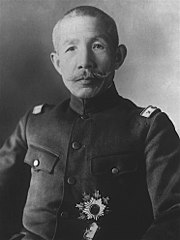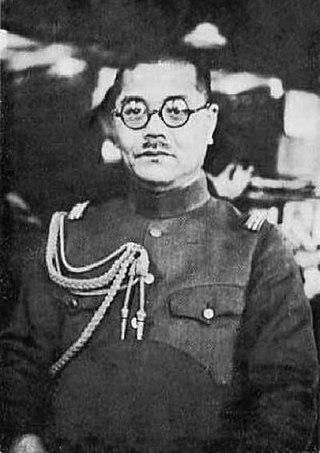This article has multiple issues. Please help improve it or discuss these issues on the talk page . (Learn how and when to remove these template messages)
|
This article has multiple issues. Please help improve it or discuss these issues on the talk page . (Learn how and when to remove these template messages)
|

The following were closely involved in the government and military of Japan:

President of Privy Council
Privy Councillors
Supreme Commander-in-Chief of Armed Imperial Forces
He also led the Imperial Supreme War Council conferences and meetings, in some cases a member of the Imperial Family was sent to represent him at such strategic conferences.
Established in 1937
Commander
Japanese Army Strategic Thought Group
Aide to War Minister, IGHQ
Staff officer IGHQ
Operations Bureau's Organization and Mobilization Section, IGHQ
Russian Section of Intelligence Department, IGHQ
Army Inner Liaison (Army Section), Military Affairs Bureau, Army Ministry, IGHQ
Imperial Japanese Army General Staff (Tokyo HQ)
Army Zone Commands
Army Regional Commands
Army Tactical Commands
General Command of Southern Army
Army Tactical Commands
Army High Level Inner Liaison with Army General Staff, IGHQ
Japanese Navy Strategic Thinking Group
Imperial Japanese Navy General Staff (Tokyo HQ)
Navy General Staff of Combined Fleet (Japan, later Truk HQ)
Navy Tactical Commands
Navy-Army General Staff (IGHQ) Liaison Officer
Inspectorate General of Military Training IGHQ
Inspectorate General of Aviation IGHQ

Chief Secretary of Supreme War Council
Supreme War Councilor

Military Councilors
" Imperial Throne Council of War "
President of the Imperial Throne Council of War
Imperial War Councilor
Organization
Army Commanders of Military Prisons and POW Camps in occupied territories
See: Military instructors and trainers of the Empire of Japan
Japanese Army Intelligence Services units
Administrative Chief of Administrative Division, Army Aeronautical Department
Chief of the Army Aviation Headquarters
Inspectorate General of Army Air Force
Air Armies General Commanders
Air Groups Commanders
Air Regiment Commanders
Air Force Brigade Commanders
Air Force Staff Officers
Officer Attached to Second Air Group HQ
Commanding Officer in Air Battalion
Acting General Officer Commanding Army Aviation Corps
Air Force Commanders, Directors and instructors in Air Schools
Chief of Army Aeronautical Department (operative unit)
Deputy Chief of Army Aeronautical Department
Chief of Second Bureau, Army Aeronautical Department
Chief of Army Air Technical Laboratories
Technicals and Experts in Army Aeronautical Sciences
Imperial Japanese Army Air Force units
64th Sentai units (Bangkok Airfield, 1941)
Kurai Chutai, 502nd Sentai unit (Nakatsu Airfield, 1945)
Hane Chutai, 2nd Air Army unit (Xinjing East Airfield, 1945)
For a complete structure see:
See:
Imperial Japanese Navy Air Force units
Fighter Unit (Carrier Akagi, 1941)
Tainan Air Corps (Denpasar Airfield, 1942)
Yokosuka Air Corps (Yokosuka Airfield, 1943)
253rd Air Corps (Rabaul Airfield, 1944)
303 Squadron, 203rd Air Corps (Kagoshima Airfield, 1945)
Japanese Navy Secret Service units
'National Economic policies'
'Planning Bureau in Cabinet Resources Board'
'Member in Cabinet Research Board'
'Imperial Planning Institute'
'1st Department, Planning Institute (Cabinet Research Board Unit)'
'Cabinet Planning Board'
'First Bureau, Cabinet Planning Board'
'General Affairs Bureau, Cabinet Planning Board'
'Secretary-General of the Asia Development Board'
'Political Affairs Section of the Asia Development Board'
'Nan-yo Kyokai'
'Nanyo Sangyo Kaisha'
'Nanyo Kohatsu Kaisha'
'Official Journalists'
'Support writers and military experts'
'Official war correspondent'
Japanese and foreign politician and military experts related to Buddhist and Tibetan topics group inside of foreign affairs ministry during 1942, for research the possibility of any operations or incursion in Tibet:[ clarification needed ]
At the 1938 Five Ministers' Conference, five of the most powerful men in Japan gathered to discuss the ideas and plans of their 'Jewish experts'.

The Imperial General Headquarters was part of the Supreme War Council and was established in 1893 to coordinate efforts between the Imperial Japanese Army and Imperial Japanese Navy during wartime. In terms of function, it was approximately equivalent to the United States Joint Chiefs of Staff and the British Chiefs of Staff Committee.
Soemu Toyoda was an admiral in the Imperial Japanese Navy in World War II.

Osami Nagano was a Marshal Admiral of the Imperial Japanese Navy and one of the leaders of Japan's military during most of the Second World War. In April 1941, he became Chief of the Imperial Japanese Navy General Staff. In this capacity, he served as the navy's commander-in-chief in the Asia-Pacific theater of World War II until his removal in February 1944. After the war, he was arrested by the International Military Tribunal for the Far East but died of natural causes in prison during the trial.
Shigetarō Shimada was an admiral in the Imperial Japanese Navy during World War II. He also served as Minister of the Navy. He was convicted of war crimes and sentenced to life imprisonment.

Manchukuo was a puppet state set up by the Empire of Japan in Manchuria which existed from 1931 to 1945. The Manchukuo regime was established four months after the Japanese withdrawal from Shanghai with Puyi as the nominal but powerless head of state to add some semblance of legitimacy, as he was a former emperor and an ethnic Manchu.

The Navy Ministry was a cabinet-level ministry in the Empire of Japan charged with the administrative affairs of the Imperial Japanese Navy (IJN). It existed from 1872 to 1945.
Organization of the Kwantung Army which was an army group of the Imperial Japanese Army of Japan.
Immediately after the fall of Singapore in 1942 certain Army circles argued that Japan should exploit her advantage and seek peace with Great Britain. The heart of this reasoning was the fact that Japan could not knock out both the United States and England, judging from such factors as a national strength and geographical location.

Toshizō Nishio was a Japanese general, considered to be one of the Imperial Japanese Army's most successful and ablest strategists during the Second Sino-Japanese War, who commanded the Japanese Second Army during the first years after the Marco Polo Bridge Incident.

The Imperial Japanese Army Railway and Shipping Section was the logistics unit of the Imperial Japanese Army charged with shipping personnel, material and equipment from metropolitan Japan to the combat front overseas.

The Imperial Japanese Army General Staff Office, also called the Army General Staff, was one of the two principal agencies charged with overseeing the Imperial Japanese Army.
Junrokurō Matsuura was lieutenant general in the Imperial Japanese Army in the Second Sino-Japanese War.

The Axis leaders of World War II were important political and military figures during World War II. The Axis was established with the signing of the Tripartite Pact in 1940 and pursued a strongly militarist and nationalist ideology; with a policy of anti-communism. During the early phase of the war, puppet governments were established in their occupied nations. When the war ended, many of them faced trial for war crimes. The chief leaders were Adolf Hitler of Nazi Germany, Benito Mussolini of Fascist Italy, and Hirohito of Imperial Japan. Unlike what happened with the Allies, there was never a joint meeting of the main Axis heads of government, although Mussolini and Hitler met on a regular basis.

Jun Ushiroku was a general in the Imperial Japanese Army.

Hideo Iwakuro was a major general in the Imperial Japanese Army during World War II. He is also known as one of the founders of the Kyoto Sangyo University.

The Allied leaders of World War I were the political and military figures that fought for or supported the Allied Powers during World War I.

Hideki Tojo was a Japanese politician, military leader and convicted war criminal who served as prime minister of Japan and president of the Imperial Rule Assistance Association from 1941 to 1944 during World War II. He assumed several more positions including chief of staff of the Imperial Army before ultimately being removed from power in July 1944. During his years in power, his leadership was marked by extreme state-perpetrated violence in the name of Japanese ultranationalism, much of which he was personally involved in.

Vice Admiral Hidemi Yoshida was a Japanese naval officer who served in the Imperial Japanese Navy from 1919 to 1945 and the Japanese Maritime Self Defense Force (JMSDF) from 1954 to 1958. He was the first Self Defense Fleet commander in 1954 until being succeeded by Vice Admiral Yasumaro Kiguchi.

Ken Terajima was a Japanese Vice Admiral and politician. He was also known for serving as the Minister of Communications from 18 October 1941 to 8 October 1943, and Minister of Railways from 18 October 1941 to 2 December 1941, in the Tōjō Cabinet.